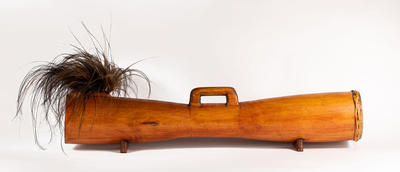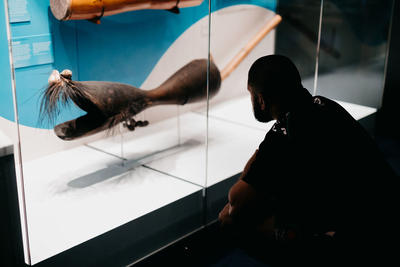Drum (buruburu)
Production date
1989
Country
Australia
State/Province
Queensland
See full details
Object detail
Description
Handle at waist, reptile skin tympanum, cassowary plume decoration at base. Varnished. Wood stand.
Classification
INDIGENOUS CULTURES Aboriginal and Torres Strait Islander drum
Maker
Production date
1989
Production place
Measurements
All 3 measurements include feathers.
Media/Materials description
Wood, reptile skin, feather, split cane, adhesive
History and use
Different cultural groups often bonded through ritual, ceremony and dance, so objects associated with these practices became significant trade items. Drums were one of the most important objects exchanged for ceremonial use. Torres Strait Islander people often acquired drums from New Guinea and, even today, the drums used in the Torres Strait are commonly sourced from New Guinea.
Drums are made from a hollowed-out single piece of wood. The tympanum - the skin end of the drum - could be covered with snake, lizard or wallaby skin. Lizard was the most common.
This drum is a buruburu (Kala Lagaw Ya language, Kalaw Kawaw Ya dialect) from Waibene (Thursday Island) in the Torres Strait. It was made by the late elder Wilfred Aniba from Saibai Island. The buruburu is often painted and engraved with a motif and decorated with cassowary feathers.
This item was most recently on display in the exhibition 'Connections across the Coral Sea: A story of movement' at Museum of Tropical Queensland (2021-2022) and Queensland Museum (2022-2023).
Drums are made from a hollowed-out single piece of wood. The tympanum - the skin end of the drum - could be covered with snake, lizard or wallaby skin. Lizard was the most common.
This drum is a buruburu (Kala Lagaw Ya language, Kalaw Kawaw Ya dialect) from Waibene (Thursday Island) in the Torres Strait. It was made by the late elder Wilfred Aniba from Saibai Island. The buruburu is often painted and engraved with a motif and decorated with cassowary feathers.
This item was most recently on display in the exhibition 'Connections across the Coral Sea: A story of movement' at Museum of Tropical Queensland (2021-2022) and Queensland Museum (2022-2023).
Registration number
QE11873




